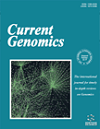- Home
- A-Z Publications
- Current Genomics
- Previous Issues
- Volume 19, Issue 2, 2018
Current Genomics - Volume 19, Issue 2, 2018
Volume 19, Issue 2, 2018
-
-
High-throughput Methods for Dissection of Trypanosome Gene Regulatory Networks
More LessFrom synthesis to decay, mRNA associates with RNA-binding proteins (RBPs) establishing dynamic ribonucleoprotein particles (RNPs). Understanding the composition and function of RNPs is fundamental to understanding how eukaryotic mRNAs are controlled. This is especially relevant for trypanosomes and related kinetoplastid parasites, which mostly rely on posttranscriptional mechanisms to control gene exp Read More
-
-
-
Gene and Chromosomal Copy Number Variations as an Adaptive Mechanism Towards a Parasitic Lifestyle in Trypanosomatids
More LessTrypanosomatids are a group of kinetoplastid parasites including some of great public health importance, causing debilitating and life-long lasting diseases that affect more than 24 million people worldwide. Among the trypanosomatids, Trypanosoma cruzi, Trypanosoma brucei and species from the Leishmania genus are the most well studied parasites, due to their high prevalence in human infections. These parasites have Read More
-
-
-
Conservation and Variation in Strategies for DNA Replication of Kinetoplastid Nuclear Genomes
More LessAuthors: Catarina A. Marques and Richard McCullochIntroduction: Understanding how the nuclear genome of kinetoplastid parasites is replicated received experimental stimulus from sequencing of the Leishmania major, Trypanosoma brucei and Trypanosoma cruzi genomes around 10 years ago. Gene annotations suggested key players in DNA replication initiation could not be found in these organisms, despite considerable conservation amongst characterised eukaryotes. Initial Read More
-
-
-
Biology of Trypanosoma cruzi Retrotransposons: From an Enzymatic to a Structural Point of View
More LessAuthors: Francisco Macias, Raquel Afonso-Lehmann, Manuel C. Lopez, Inmaculada Gomez and M. C. ThomasIntroduction: An important portion of the Trypanosoma cruzi genome is composed of mobile genetic elements, which are interspersed with genes on all chromosomes. The L1Tc non-LTR retrotransposon and its truncated version NARTc are the most highly represented and best studied of these elements. L1Tc is actively transcribed in all three forms of the Trypanosoma parasite and encodes the proteins that enable it to autonom Read More
-
-
-
Transcriptional Regulation of Telomeric Expression Sites and Antigenic Variation in Trypanosomes
More LessAuthors: Igor Cestari and Ken StuartIntroduction: Trypanosoma brucei uses antigenic variation to evade the host antibody clearance by periodically changing its Variant Surface Glycoprotein (VSGs) coat. T. brucei encode over 2,500 VSG genes and pseudogenes, however they transcribe only one VSG gene at time from one of the 20 telomeric Expression Sites (ESs). VSGs are transcribed in a monoallelic fashion by RNA polymerase I from an extranucleolar sit Read More
-
-
-
Introgression of the Kinetoplast DNA: An Unusual Evolutionary Journey in Trypanosoma cruzi
More LessIntroduction: Phylogenetic relationships between different lineages of Trypanosoma cruzi, the agent of Chagas disease, have been controversial for several years. However, recent phylogenetic and phylogenomic analyses clarified the nuclear relationships among such lineages. However, incongruence between nuclear and kinetoplast DNA phylogenies has emerged as a new challenge. This incongruence implies several ev Read More
-
-
-
Epigenetic Regulation of Transcription in Trypanosomatid Protozoa
More LessThe Trypanosomatid family includes flagellated parasites that cause fatal human diseases. Remarkably, protein-coding genes in these organisms are positioned in long tandem arrays that are transcribed polycistronically. However, the knowledge about regulation of transcription initiation and termination in trypanosomatids is scarce. The importance of epigenetic regulation in these processes has become evident in the last ye Read More
-
-
-
Leptomonas pyrrhocoris: Genomic insight into Parasite's Physiology
More LessBackground: Leptomonas pyrrhocoris is a parasite of the firebug Pyrrhocoris apterus. This flagellate has been recently proposed as a model species for studying different aspects of the biology of monoxenous trypanosomatids, including host – parasite interactions. During its life cycle L. pyrrhocoris never tightly attaches to the epithelium of the insect gut. In contrast, its dixenous relatives (Leishmania spp.) establish a sta Read More
-
Volumes & issues
-
Volume 26 (2025)
-
Volume 25 (2024)
-
Volume 24 (2023)
-
Volume 23 (2022)
-
Volume 22 (2021)
-
Volume 21 (2020)
-
Volume 20 (2019)
-
Volume 19 (2018)
-
Volume 18 (2017)
-
Volume 17 (2016)
-
Volume 16 (2015)
-
Volume 15 (2014)
-
Volume 14 (2013)
-
Volume 13 (2012)
-
Volume 12 (2011)
-
Volume 11 (2010)
-
Volume 10 (2009)
-
Volume 9 (2008)
-
Volume 8 (2007)
-
Volume 7 (2006)
-
Volume 6 (2005)
-
Volume 5 (2004)
-
Volume 4 (2003)
-
Volume 3 (2002)
-
Volume 2 (2001)
-
Volume 1 (2000)
Most Read This Month
Article
content/journals/cg
Journal
10
5
false
en


